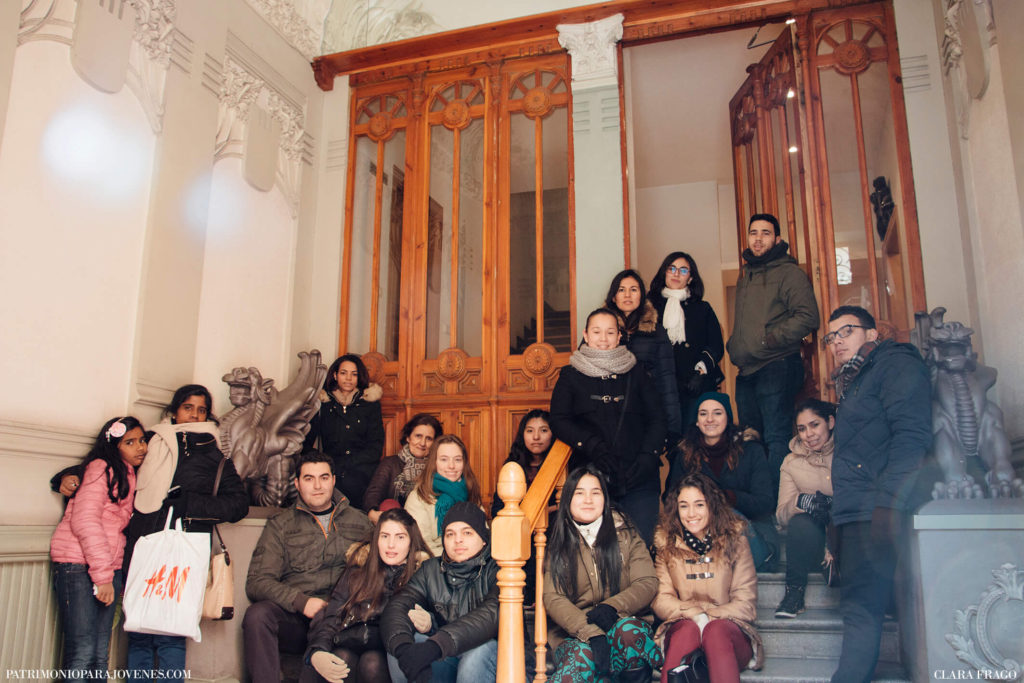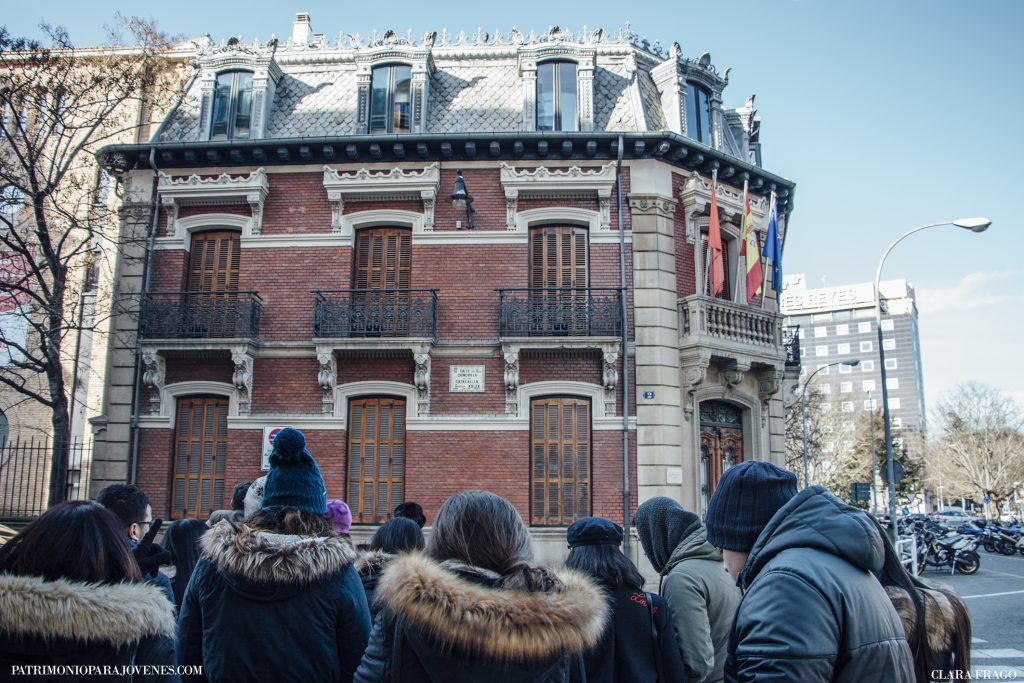The Royal Academy of Fine Arts of San Fernando Gathers Together to Members and Friends of Patrimonio para Jóvenes.
 With the 300th anniversary of the birth of Ventura Rodríguez, the Royal Academy of Fine Arts of San Fernando, organized an exposition about the architect. This was the perfect occasion to meet up with our members from Madrid and its surroundings. And a perfect occasion to invite them to see Ventura Rodriguez´s work in Navarre. Since not all of us could come, we organized a raffle to see who was coming. The exhibition was magnificent. You´re still on time to make a visit, since it´ll stay until april 8th. If you want more information, click here.
With the 300th anniversary of the birth of Ventura Rodríguez, the Royal Academy of Fine Arts of San Fernando, organized an exposition about the architect. This was the perfect occasion to meet up with our members from Madrid and its surroundings. And a perfect occasion to invite them to see Ventura Rodriguez´s work in Navarre. Since not all of us could come, we organized a raffle to see who was coming. The exhibition was magnificent. You´re still on time to make a visit, since it´ll stay until april 8th. If you want more information, click here.
On this picture you can see some of the youngest members. And it was Maria, the littlest of all, the third from the left, who won the contest to come to visit us in Navarre. She did it a few days later, accompanied by her mother, Nuria.
Discover, Relate, Learn, Enjoy
The exhibition about Ventura Rodríguez had a Little “but”: it could be too complex and hard to be appreciated or enjoyed by the youngest observers. With Ana, our guide, we did what we could in order to make it more approachable, talking about something very well known: The Fountain of the goddess Cibeles.
Designed by Ventura Rodríguez (although it was built by two othe sculptors) is an emblematic fountain, a “must” stop in Madrid. Either you are a soccer fan or not, everybody relates this fountain with Real Madrid. This helped us as a hook to demonstrate the importance of Ventura Rodríguez, his projects and works.
If you want tocheck out more about the category, complexity and setting of this exhibition in Madrid, you can watch this video.
By the way, it would be an authentic delight to have an encounter of the Patrimonio para Jóvenes “troupe” with the staff in charge of the setting of this exhibition and other not-less-important ones: Arquitectos Frade
Along the explanations we started to familiarize ourselves with Ventura Rodríguez and his work. Little by little, the curiosity about his work in Navarra started to flourish.
By the end of our visit, we made the raffle. We had a little bag with blank pieces of paper, except for one that had PAMPLONA written on it. The one who took this piece of paper would come to Navarra to see the façade of the Cathedral, the Bell Tower, the Noain aqueduct, and of course, to enjoy the city.
And the Winner is…Maria!
The youngest member of our group was the fortunate one. As an anecdote, she took the papero ut of the bag without noticing she was the winner. For some reason, she thought that each of us was taking a piece of paper with the name of a different city, so she didn´t say anything. It was her mother who noticed. As you can imagine, Little Maria had a hard time being the center of attention, clapped and cheered by all of us. You could say this is a very personal and very intense way to discover Ventura Rodríguez .
It was a February afternoon, intense, kind, full of encounters, introductions, memories and all these details that come with the effort of making a visit. We said good bye and went to our respective Metro stations, buses and plans. However, all of us left with the feeling of being part of something bigger that gathers people together no matter their age, origins or education. It was the interest in appreciating and discovering our culture.
Two Visits in Pamplona: First: The Cathedral and its Tower
In Patrimonio para Jóvenes we don´t like rushing nor overwhelming people with contents and information. We prefer little drops, generate curiosity step by step. And overall, we want people to have a great time with us. Let´s not forget that we are addressing to the most complex public: The one who generally is not interested in this kind of activities. So we have to awaken their interest, our biggest challenge. And this can only be done with care, preparing every visit with an artisan’s technique.
A VIP Guide…
There´s no better way of showing the love that we put into our work tan visiting the Cathedral of Pamplona (relating the visit to Ventura Rodríguez) with Verónica Quintanilla Crespo, an architect specialized in restoring cultural heritage. You can see her on the picture above.
Verónica and her team were in charge of the restoration of the facade of the Cathedral of Pamplona.
All the visitors were amazed and said that they were discovering a new perspective of the Cathedral. They´d never seen nor thought about many of the details Verónica talked about.
While Verónica explained, Clara Frago captured with her camera those instants of communion and harmony of diverse environments. Surroundings where we discover new projects and designs for the façade of the Cathedral at the same time we re-imagine how the primitive Romanic façade would have looked like.
It was very interesting to listen to Verónica and how she approached us to Ventura Rodríguez ant to the Cathedral with the delicacy of someone who has had to listen, discover, observe and interpret to a great architect in order to intervene on his work. Take it back to its original glow with humility and generosity.
“An architect that restores cultural heritage has to be humble”. I couldn´t resist falling for this comment. In a restoration project, the personal mark is not important; the main objective is to give back the starring light to the geniuses who created that piece of art. It was an amazing morning, another one on this February centered on Ventura Rodríguez. All this was occurring at the same time we were preparing Clara´s exhibition, that you´ll be able to visit in the main headquarters of La Caixa in Pamplona until April 15th.
It was such a pity that all of us started moving around, so just half of the group is shown in this
The Visit to the Aqueduct of Noain
A week later we got together again to have a walk around Noain and enjoy the views of its aqueduct. This time, our photographer was Borja Centenera Crespo.
A lot of us have seen the aqueduct many times while being on the highway or by train. None of us had ever gone below its arches, and all of us agreed that the view is completely different. From below, you can appreciate the whole magnitude of this work. We talked about the way water used to be brought to Pamplona and reflected about the problem of water supplying and how we take for granted daily activities like opening the water tap, take a shower, or doing the laundry.
And of course, we thought about all the work that building an aqueduct demands.
The aqueduct of Noain also helped us remember the fountains of the city of Pamplona that received wáter thanks to the aqueduct. Since it was impossible to visit them during the day, I took pictures of them a few days earlier and then sent them through Whatsapp.
We talked about math and physics, the awareness of land, and overall, we had a blast. As always, Borja took fantastic pictures of our day.
A February that will be saved in our memories, a month dedicated to the architect Ventura Rodríguez. This poster, designed by our wonderful Clara, is the one she created to announce
Every time I write about our activities, I get the exact same feeling. How long and slow it feels when preparing the activities, and how fast it occurs later, how easy it becomes a souvenir. Some of our members leave us, most of them to prepare the MIR exam after their Medicine degree. But new generations are to come, so Patrimonio para Jóvenes keeps on working.
I say goodbye for now with this pic of the newly arrived members and a video about Ventura Rodríguez that´s worth watching over here.
So long, Ventura Rodríguez



















































 A cold winter Saturday evening, a charming bookshop, a historical novel and its writer in our informal conference dinner, could you imagine anything better?
A cold winter Saturday evening, a charming bookshop, a historical novel and its writer in our informal conference dinner, could you imagine anything better?

